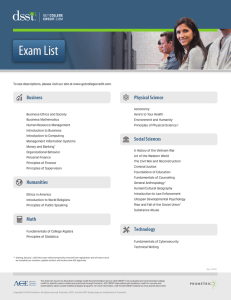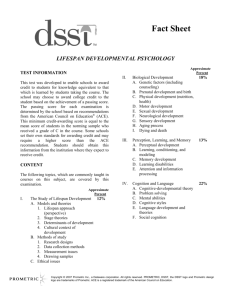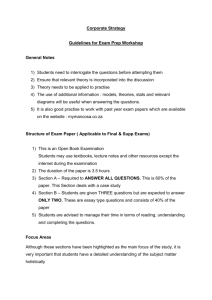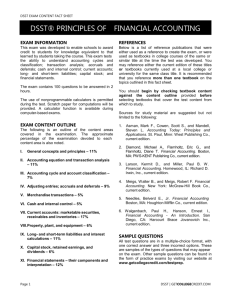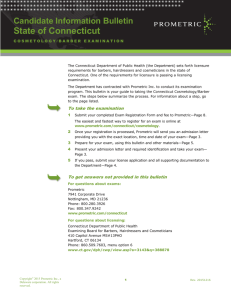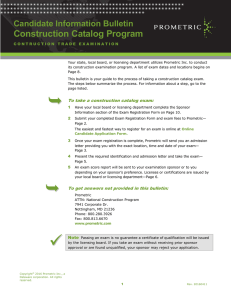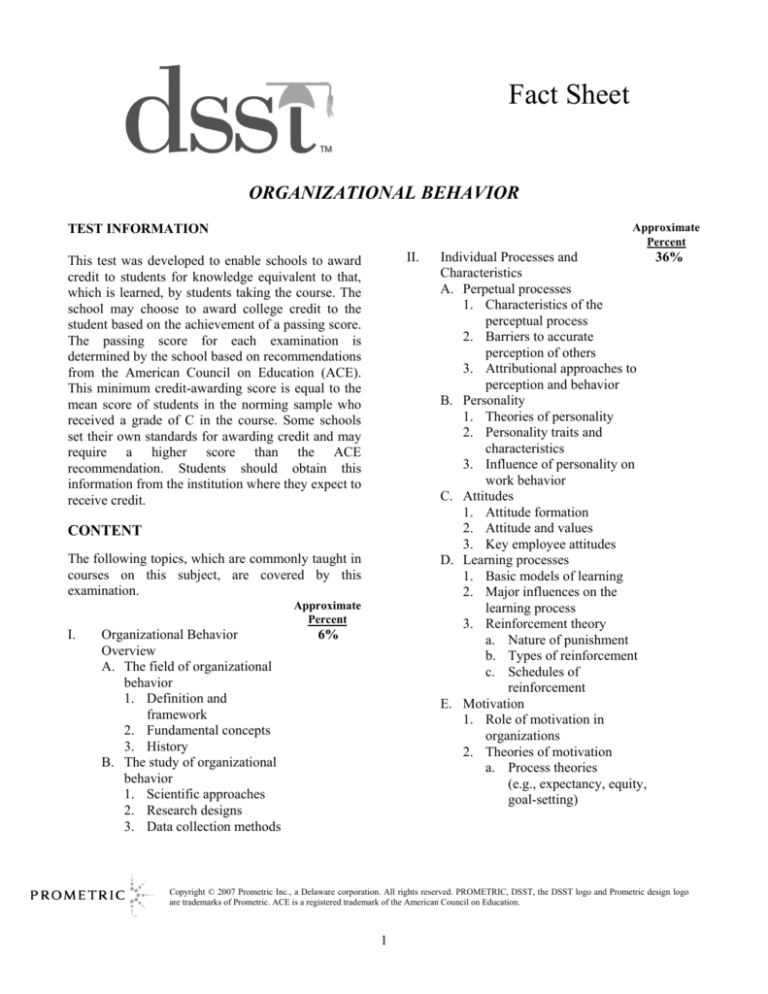
Fact Sheet
ORGANIZATIONAL BEHAVIOR
Approximate
Percent
TEST INFORMATION
II.
This test was developed to enable schools to award
credit to students for knowledge equivalent to that,
which is learned, by students taking the course. The
school may choose to award college credit to the
student based on the achievement of a passing score.
The passing score for each examination is
determined by the school based on recommendations
from the American Council on Education (ACE).
This minimum credit-awarding score is equal to the
mean score of students in the norming sample who
received a grade of C in the course. Some schools
set their own standards for awarding credit and may
require a higher score than the ACE
recommendation. Students should obtain this
information from the institution where they expect to
receive credit.
CONTENT
The following topics, which are commonly taught in
courses on this subject, are covered by this
examination.
Approximate
Percent
I.
Organizational Behavior
Overview
A. The field of organizational
behavior
1. Definition and
framework
2. Fundamental concepts
3. History
B. The study of organizational
behavior
1. Scientific approaches
2. Research designs
3. Data collection methods
6%
Individual Processes and
36%
Characteristics
A. Perpetual processes
1. Characteristics of the
perceptual process
2. Barriers to accurate
perception of others
3. Attributional approaches to
perception and behavior
B. Personality
1. Theories of personality
2. Personality traits and
characteristics
3. Influence of personality on
work behavior
C. Attitudes
1. Attitude formation
2. Attitude and values
3. Key employee attitudes
D. Learning processes
1. Basic models of learning
2. Major influences on the
learning process
3. Reinforcement theory
a. Nature of punishment
b. Types of reinforcement
c. Schedules of
reinforcement
E. Motivation
1. Role of motivation in
organizations
2. Theories of motivation
a. Process theories
(e.g., expectancy, equity,
goal-setting)
Copyright © 2007 Prometric Inc., a Delaware corporation. All rights reserved. PROMETRIC, DSST, the DSST logo and Prometric design logo
are trademarks of Prometric. ACE is a registered trademark of the American Council on Education.
1
Approximate
Percent
Approximate
Percent
b. Content theories (e.g.,
Maslow’s theory of
hierarchy of needs,
Herzberg’s two-factor
theory, Alderfer’s
ERG-existence,
relatedness, and growththeory, McClelland’s
achievement theory)
3. Application in organizations
a. Behavior modification
b. Job design
c. Reward systems
4. Evaluation of theories and
models of motivation
5. Implications for managers
F. Work stress and the individual
1. Nature of stress
2. Causes and consequences of
stress
3. Coping with stress—
individual and organizational
approaches
III.
E. Communication processes
1. The communication process
2. Models of interpersonal
communication styles
3. Communication networks
4. Barriers to effective
communication within
organizations
5. Nonverbal communication
Interpersonal and Group Processes
32%
and Characteristics
A. Group dynamics
1. Types of groups
2. Reasons for group formation
3. Stages of group development
4. Characteristics of groups
B. Group behavior and conflict
1. Levels of conflict
2. Consequences of functional
and dysfunctional conflict
3. Conflict management
C. Leadership
1. Nature of the leadership
process
2. Models of leadership
3. Evaluation of models of
leadership
4. Implications for managers
D. Power and politics
1. Power and influence
2. Interpersonal sources of power
3. Structural and situational
sources of power
4. Political behavior in
organizations
2
IV.
Organizational Processes and
Characteristics
A. Organizational decision-making
1. Classification and definition
of decisions
2. Models of the
decision-making process
3. Individual vs. group
decision-making
B. Organization structure
1. Dimensions of organization
structure
2. Types of organization
structure
3. Responsibility and authority
C. Organization design
1. Classic approaches
2. Contingency approaches
19%
V.
Change and Development Processes
7%
A. Basic processes and concepts of
change
1. Pressures for change
2. Models and processes for
planned organizational change
3. Resistance to organizational
change
4. Corporate culture
B. Applications and techniques of
change and development
1. Overview of organization
development
2. Group and individual change
3. Sociotechnological approaches
to change
4. Structural approaches to change
Questions on the test require candidates to
demonstrate the following abilities. Some questions
may require more than one of the abilities.
•
Knowledge of basic facts and terms
(about 50-55% of the examination)
•
Understanding of concepts and principles
(about 30-35% of the examination)
•
4. Which of the following is one reason why
Herzberg's two-factor theory is viewed as
controversial?
(A)
(B)
(C)
Ability to apply knowledge to specific problems
and situations
(about 10-15% of the examination)
(D)
SAMPLE QUESTIONS
5. Standing close to another individual to
communicate a sense of power is an example of
1. An employee who bases his or her
job-evaluation rating on an unfair rating form
may be
(A)
(B)
(C)
(D)
It states that job satisfaction and
dissatisfaction do not exist on a single
continuum.
It does not explain why people desire to
achieve.
It states that organizational policies have
too strong an impact on intrinsic
rewards.
It does not explain why people choose
particular behaviors to accomplish
work-related goals.
(A)
(B)
(C)
(D)
stereotyping supervisory personnel
engaging in perceptual defense
making a causal attribution
learning about job tasks
an authority stance
a stereotype
a nonverbal cue
a leadership behavior
6. From the organization's perspective, which of
the following is an example of a positive norm?
2. Which of the following accurately lists needs in
Maslow's hierarchy?
(A)
(A)
(B)
Physiological, power, growth, and esteem
Security, esteem, power, and
self-actualization
(C) Security, belonging, mastery,
psychological, and self-esteem
(D) Physiological, security, belonging, esteem
and self-actualization
3. Operant conditioning is primarily
concerned with
(A) physiological causes of behavior
(B) cognition of behavior
(C) consequences of behavior
(D) punishment of behavior
(B)
(C)
(D)
The appearance of working hard,
regardless of results
The use of group sanctions against the
person who exceeds productivity levels
A general practice of arriving to work
on time
A supervisor's public criticism of a
subordinate's poor performance
7. Which of the following statements best
describes the path-goal theory of leadership?
(A)
(B)
(C)
(D)
3
It focuses on goals to achievement.
It measures the philosophical assumptions
behind a leader's style.
It looks at leader behaviors, subordinate
characteristics, and environmental
pressures.
It emphasizes personality traits critical for
effective leadership.
8. George Bacon is considered one of the leading
surgeons in the field of artificial heart
transplants. Even though he is not associated
with Western Memorial Hospital, he exerts
much influence over many of the surgeons there.
Such influence is best termed
(A)
(B)
(C)
(D)
Davis, Keith A., and John W. Newstrom. Human
Behavior at Work: Organizational Behavior. New
York: McGraw-Hill, current edition.
Gibson, James L., John M. Ivancevich, and James H.
Donnelly, Jr. Organizations: Behavior, Structure,
Processes. Chicago, IL: Irwin, current edition.
legitimate power
coercive power
reward power
expert power
Gordon, Judith R. A Diagnostic Approach to
Organizational Behavior. Upper Saddle River, NJ:
Prentice Hall, current edition.
9. Which of the following is a major feature of a
matrix organization?
(A)
(B)
(C)
(D)
Hellriegel, Don, John W. Slocum, and Richard W.
Woodman. Organizational Behavior. Cincinnati,
OH: South-Western College Publishing, current
edition.
Provision for horizontal communication
Establishment of profit centers
Presence of employees with two
supervisors
Increased separation of line and staff
responsibilities
Luthans, Fred. Organizational Behavior. New York:
McGraw-Hill, current edition.
Moorhead, Gregory, and Ricky W. Griffin.
Organizational Behavior: Managing People and
Organizations. Boston: Houghton-Mifflin, current
edition.
10. Which of the following statements is NOT true
about organizational development (OD)?
(A)
(B)
(C)
(D)
It is a system-wide change effort.
It frequently leads to new organizational
structures.
It is characterized by participatory
methods of change.
It emphasizes short-term rather than longterm methods of change.
Newstrom, John W., and Keith Davis.
Organizational Behavior: Human Behavior at Work.
New York: McGraw Hill, current edition.
Organ, Dennis W., and Thomas S. Bateman.
Organizational Behavior: Homewood, IL: Irwin,
current edition. (Note: this is a slightly advancedlevel text).
STUDYING FOR THE EXAMINATION
The following is a list of reference publications that
were being used as textbooks in college courses of
the same or similar title at the time the test was
developed. Appropriate textbooks for study are not
limited to those listed below. If you wish to obtain
study resources to prepare for the examination, you
may reference either the current edition of the
following titles or textbooks currently used at a local
college or university for the same class title. It is
recommended that you reference more than one
textbook on the topics outlined in this fact sheet.
You should begin by checking textbook content
against the content outline included on the front
page of this Fact Sheet before selecting textbooks
that cover the test content from which to study.
Textbooks may be found at the campus bookstore of
a local college or university offering a course on the
subject.
Sources for study material suggested but not limited
to the following:
Robbins, Stephen P. Organizational Behavior:
Concepts, Controversies, Applications. Upper
Saddle River, NJ: Prentice Hall International, current
edition.
Robbins, Stephen P. Essentials of Organizational
Behavior. Upper Saddle River, NJ: Prentice Hall
International, current edition.
Schermerhorn Jr., John R., James G. Hunt, and
Richard N. Osborn. Organizational Behavior. New
York: Wiley, current edition.
Current textbook used by a local college or
university for a course on the subject.
4
CREDIT RECOMMENDATIONS
INFORMATION
The Center For Adult Learning and Educational
Credentials of the American Council on Education
(ACE) has reviewed and evaluated the DSST
examination development process. ACE has made
the following recommendations:
Colleges and universities that would like additional
information about the national norming, or
assistance in local norming or score validation
studies should write to: DSST Program, Prometric,
2000 Lenox Drive, 3rd Floor, Lawrenceville, NJ
08648.
Organizational Behavior
Lower level Baccalaureate
Three (3) semester hours
ACE Commission on
Educational Credit and
Credentials
It is advisable that schools develop a consistent
policy about awarding credit based on scores from
this test and that the policy be reviewed periodically.
Prometric will be happy to help schools in this
effort.
Correct Responses: 1.B; 2.D; 3.C; 4.A; 5.C; 6.C; 7.C; 8.D; 9.C; 10.D.
Area or Course
Equivalent:
Level:
Amount of Credit:
Source:
5
Rev. 20071116 - I.N. 390531

